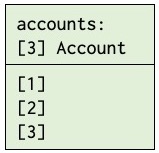A customer may have more than one account. In this section, we extend class Customer to keep track of the accounts of a given customer.
We may use class Set for this purpose, but we use this example to introduce Array, which is another common collection object. An Array-object is an indexed sequence of references to objects where each reference in the sequence may be denoted by an integer index.

Class Array is defined as follows:
class Array(range: var integer, class ElmType:< Object):
put(R: ref ElmType):at[index: var integer]:
...
get(index: var integer) -> R: ref ElmType:
...- The first parameter,
rangeofArrayis the number of elements in theArray. - The second paremeter,
ElmType, is the type of the elements in theArray– similar toElmTypefor classSet. - It has a method
put:atwith two parametersRandindex. This method stores the reference at the position given by the value ofindex. - It has a method
get, which returns the reference stored at the position given by the parameterindex. - As can be seen,
put:atandgetuse another syntax for defining parameters than the one we have seen in previous examples using standard brackets and comma to separate the parameters. This syntax is explained in section .
The following example shows how we may use an Array-object, accounts. Below we add accounts as an attribute of class Customer, but first we show how to use Array by means of a ghost object.
aGhost1: obj
accounts: obj Array(3, Account)
anAccountA, anAccountB : ref Account
JohnSmithProfile: ref Customer -- skal vi bruge obj her?
JohnSmithProfile := Customer("John Smith")
anAccountA := Account(JohnSmithProfile)
accounts.put(anAccountA):at[2]
anAccountB := accounts.get[2]- The first item in the example above declares an
Array-object with 3 elements (the first parameter) of typeAccount(the second parameter). - The statement
accounts.put(anAccountA):at[2]inserts theAccountreferred to byanAccountAas the second element in the array. - The statement
anAccountB := accounts.get[2]assigns the second element in the array to the referenceanAccountB.
The situation at the end of aGhost1 is shown in the snapshot:

An index may in general be an expression that evaluate to an integer value as shown in the ghost object below:
aGhost2: obj
accounts: obj Array(3, Account)
anAccountA, anAccountB, anAccountC : ref Account
inx: var integer
... -- some code assigning references to anAccountA and anAccountB
inx := 1
accounts.put(anAccountA):at[inx]
accounts.put(anAccountB):at[inx + 1]
inx := 3
anAccountC := accounts.get[inx - 2]- The object
aGhost2has anArrayaccountswith 3 elements of typeAccount, three reference variablesanAccountA,anAccountB, and anAccountC, and an integer variableinx. - The three dots
...stand for code not shown – see chapter . - The variable
inxassigned the value 1. - The expression
accounts.put(anAccountA):at[inx]assigns the reference hold byanAccountAto element no. 1 inaccounts, since the value ofinxis 1. - The expression
accounts.put(anAccountB):at[inx + 1]assigns the reference hold byanAccountBto element no. 2 inaccounts, since expressioninx + 1has the value 2. - The statement
anAccountC := accounts.get[inx - 2]assigns element no. 1 inaccountstoanAccountCsince expressioninx - 2has the value 3 (asinxis assigned the value 3 before the statement) –anAccountCwill thus refer to the same object asanAccountA.
If the index expression is not within the range of the array – here 1-3, the program execution will be terminated (aborted) with an error message saying that there is an index error.
We may now extend class Customer with an array keeping track of the accounts of the customer:
class Customer(name: var String):
addr: var String
email: var String
maxNoOfAccounts: val 10
noOfAccounts: var integer
accounts: obj Array(maxNoOfAccounts, Account)In the example, we assume that a customer may have at most 10 accounts as represented by the constant integer value maxNoOfAcounts. The integer variable noOfAccounts holds the number of accounts of the customer. An integer variable like noOfAccounts has initially the value 0 (zero).
Next we add a method addAccount to class Customer:
class Customer(name: var String):
-"-
addAccount(acc: ref Account):
noOfAccounts := noOfAccounts + 1
if (noOfAccounts <= maxNoOfAccounts) :then
accounts.put(acc):at[noOfAccounts]
:else
console.print(“Cannot add Account”) The method has a parameter acc referring to the Account to be added. An if:then:else statement is used to test if it is possible to add an account or if the limit of the maximum number of accounts has been reached in which case a message is printed on the console.
The if:then:else statement is similar to the if:then statement as explained in section . The part after else is executed if the condition is false. For a more detailed description see section on statements.
Next we add a method that calculates the sum of the balance on all accounts:
class Customer(name: var String):
-"-
balanceSum -> bal: var float:
for (1):to(noOfAccounts):repeat
bal := bal + accounts.get[inx].balanceThe method makes use of a for-statement, for:to:repeat – also called for-loop, that iterates through the elements of the array. For each value in the interval 1..noOfAccounts, the statement bal := bal + accounts.get[inx].balance is executed. The variable inx has the value 1 in the first execution 2 in the second and so one and noOfAccounts in the last execution. For a more detailed description see section .
The complete new version of class Customer is shown here:
class Customer(name: var String):
addr: var String
email: var String
maxNoOfAccounts: val 10
noOfAccounts: var integer
accounts: obj Array(maxNoOfAccounts,Account)
addAccount(acc: ref Account):
noOfAccounts := noOfAccounts + 1
if (noOfAccounts <= maxNoOfAccounts) :then
accounts.put(acc):at[noOfAccounts]
:else
console.print(“Cannot add Account”)
balanceSum -> bal: var float:
for(1):to(noOfAccounts):repeat
bal := bal + accounts.get[inx].balance Array literal bør indføres her, men mangler et oplagt eksempel. Kan selvfølgelig bare vise et demo eksempel med fx 3 Accounts a la accounts := (acc1,acc2,acc3) men ikke ideelt.
